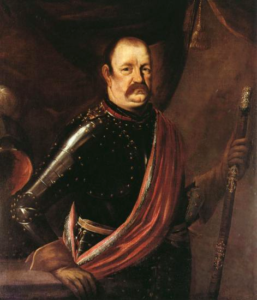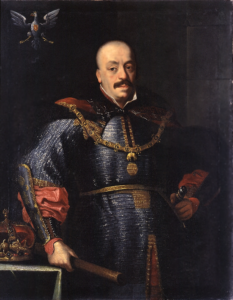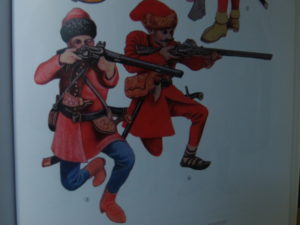1657: the unlucky Polish war of Prince Rákóczi György II
The beginning
Many people today think that the prince’s unfortunate military action was only the result of his selfish conquest policy, which lacked any kind of responsibility and led to the fall of Transylvania. However, there were very few who would have dissuaded the prince when the war was declared. Lórántffy Zsuzsanna, the prince’s mother, was one of those few. Many others welcomed the campaign and the vengeful Ottoman campaign was not obvious. It was because the Sultan’s power had been weakening for decades, and the Sublime Porte had only warned its vassals on such occasions but had never sent an army to take revenge for disobedience. (Please note that I use the Oriental name order for Hungarians, where the surname comes first).

Neither Prince Rákóczi nor any of his contemporary politicians were able to notice the serious reforms initiated by Pasha Köprülü Mehmed and they did not realize that the Sublime Porte had been revived and it was not the dying empire as it had seemed. Besides, everybody remembered Báthory István (Stephen) who had become the king of Poland and the union of the two countries would have been a serious opportunity to liberate the whole Kingdom of Hungary from the Turks. But let us not forget that he was a Roman Catholic. However, I have a question: how could the Protestant Rákóczi György II ever imagine himself as the king of the Catholic Polish people? Surely he could not have imagined that the Polish nobility would ally with the Muslim Crimean Tatars against him…

Prince Rákóczi György II inherited the interest in the Polish throne from his father, Prince Rákóczi György I, who was also a Protestant. At that time, Poland seemed to be weakened, as it was threatened not only by the Turks but also by the Russians and the Swedes, along with Brandenburg-Prussia. In addition, the free Cossacks of Hetman Bogdan Hmelnickij were rioting in its borderland, they revolted against the Polish king in 1648. The Crimean Tatars allied with their eternal enemies, the Cossacks, and together they defeated the Polish armies one by one. King Vladislav IV died in 1648 and was succeeded by his younger brother, King János Kázmér (Casimir). King Kázmér had to make a truce with Hetman Hmelnickij (Bohdan Mychajlowytsch Chmelnyzky).

The Hetman was looking for allies, so in 1651 he signed a treaty with Prince Rákóczi György II. The prince wanted to make Transylvania a regional power in the Black Sea area. The Cossacks were supported by the Russian Tsar Aleksei, who wanted to gain new lands along the Dnieper and Volga rivers. Ukraine joined Russia in 1654, but Poland had to prevent this, so war broke out between the two countries. Hmelnickij continued his political intrigues and allied with the Voivode of Moldavia, Gheorghe Stefan, and the Voivode of Wallachia, Constantine I Serban. Both were nominally vassals of Rákóczi and the Turks. It was Prince Rákóczi who had helped Stephen to take the throne. All in all, there was a Cossack-Russian coalition and a Transylvanian-Moldavian-Wallachian-Cossack coalition, both against Poland.

It was not fortunate for the Poles that the northern kingdom of Sweden expanded its power and the young and energetic King Gustav X Charles became their king, who wanted to take land from Poland. He sent his armies in June 1655. The Northern War broke out, which the Polish called the “Deluge” because the armies of many nations flooded their land. We can read this great story in the world-famous novels of Henryk Sienkiewicz. (My note: I grew up reading them several times 🙂 Also, do not miss the movies made about it in 1974).

Read the map like this: Greenish: Holy Roman Empire
Black: Swedish troops’ camps, winter 1656/57
Purple: Polish troops’ meeting point, spring 1657
Green: Rákóczi’s troops’ location on 15 June
Dark pink: The meeting point of Polish-Lithuanian troops, summer 1657
Black/purple squares: castles in Swedish or Polish hands
Black arrow: Swedish moves
Green arrow: Transylvanian (and Moldavian / Wallachian) moves
Green arrow with dots: Cossack moves
Purple arrow: Polish moves
Brown arrow: Crimean Tatar moves
Purple arrow with dots: Imperial moves

The Russians seized Ukraine and Lithuania, the Swedes occupied Prussia, and a considerable part of Poland and Warsaw also fell. The rest of Poland seemed unable to stop the flood in 1657. King János Kázmér appealed to the Holy Roman Emperor Ferdinand III for help, but the emperor did nothing. The Swedes were stopped by the Poles in 1656, though with hard fights, and that is why King Gustav Charles turned to Prince Rákóczi for help. Rákóczi asked for the permission of the Sublime Porte, but he did not get it, but his campaign was not forbidden either.

Rákóczi’s campaign
It was on January 18, 1657, that Prince Rákóczi György II started his campaign to Poland. More precisely, in the first half of 1657, he moved his armies from Visk towards the Polish border. Due to the hard winter, it was very difficult to cross the Carpathian Mountains through the Verecke Pass. It was the middle of February when he joined the Cossack army near Przemysl. They numbered 50,000 men. However, the outcome of the campaign was foreshadowed by the attitude of the larger cities such as Lviv, Szambor, and Przemysl, which were not willing to open their gates to Rákóczi.

Crown Hetman Lubomirski stopped his military actions when he heard of Rákóczi’s approach (he was besieging Krakow, which was defended by the Swedish general Würtz). Although Lubomirski had previously promised Rákóczi that he would make him king of Poland if he entered the country with his army, he now denied this statement. In response, Rákóczi had Lubomirski’s property in Łańcú plundered by troops led by Kemény János. The Hungarian army gained a very bad reputation for plundering churches and monasteries, torturing priests and monks, and even digging up graves in search of gold. More raids, plundering, and destruction began. The Polish troops did not fight, but from time to time they ambushed the Hungarian-Cossack-Moldavian army.

Rákóczi marched with great determination to Kraków, the coronation city. He entered the city at the end of March, but stayed only two days, as his priority was to meet the army of the Swedish king. He left behind about 2,000 Transylvanian troops to support Würtz and marched out of the city on March 31st.

On April 12, he met King Gustav Charles in Sandomierz, but both were disappointed. The Swedish ruler criticized the quality of the Hungarian-Walachian-Cossack army and Rákóczi was embittered by the small size of the Swedish army, which numbered 10-12,000 men.

Meanwhile, the national feeling in Poland was growing. Slowly the Polish king and Lubomirski, Potocki, and the Lithuanians began to join forces in the Sandomierz-Lublin area. Gustavus Charles tried to outflank the Polish-Lithuanian army from all sides, but it slipped out of the trap. On the other hand, the military movements provoked fights between the Cossacks and the Transylvanians due to disputes over the booty. Rákóczi could do little about the deteriorating discipline. The problem reached its peak during the capture of Breszt when the Cossacks claimed the town as their own. It was the time when King Gustav Charles left Rákóczi behind because Denmark declared war on him and his power in Prussia was also weakened.

Rákóczi decided to follow the Swedes, but at this point, the Cossacks refused his order and revolted. The prince’s army, reduced in size and morale, moved to Warsaw, which opened its doors only after a few days of resistance. On June 22, the coalition army entered the city and plundered it, competing to see who could loot more. By this time, the coalition against the Swedish-Cossack-Transylvanian alliance had already taken shape, and the Poles were able to ally themselves with the Crimean Caganate.

Moreover, the Poles at the Sublime Porte were able to get Prince Rákóczi ordered to return to Transylvania. (Rákóczi did not obey.) In addition, the new Holy Roman Emperor, Leopold I, sent an army to help King János Kázmér (John II Casimir). In addition, Denmark was incited to attack Sweden. Meanwhile, Hmelnickij had broken his alliance with Russia, which had meanwhile made peace with the Poles in exchange for Lithuania and Ukraine.
General Lubomirski broke into northeastern Hungary with a smaller force and devastated the area around Munkács, similar to what the Hungarians had done to his domains. They burned down 300 settlements and killed women and children in Beregszász who were coming home from mass. They rest in peace in unmarked graves in front of the church of Beregszász. The Catholic Church of Beregszász was also destroyed, and many castles and churches were destroyed, such as Borsova Castle and the Church of Kismuzsaly.

The Sublime Porte sent a more severe order to Rákóczi, demanding his return and threatening him with a Turkish-Crimean Tatar punitive campaign if he did not obey. Rákóczi tried to bribe the Turkish leaders, but it was in vain because Pasha Köprülü was an incorruptible man. Rákóczi’s situation became more and more desperate. He offered peace to King János Kázmér, but he was not willing to negotiate with him. Then he turned to Hmelnickij and asked him for help. In June, Rákóczi marched from Warsaw to Sandomierze.
Meanwhile, the Hungarian garrison of Krakow was killed by the Imperial troops. At this point, Rákóczi’s last Polish allies abandoned him, and he had to drag his army across the Vistula River, supported only by his Cossack allies. When he crossed the river on July 3, he had his baggage set on fire and his cannons submerged to reach Transylvania faster.

The Polish army harassed his marching troops with constant attacks. Czarniecki slaughtered 3,000 Transylvanian men at Magierów and Kulików. When they decided to rescue the army to the Cossack lands, about 3-4,000 Transylvanians revolted and left the army. Finally, on July 22, Rákóczy made a humiliating truce with the Poles, promising to leave the country. In return, he renounced his claim to the Polish throne, agreed to pay a huge ransom, and offered his military assistance to Poland. Hearing this, the Cossacks left his army.

However, the truce did not stop the Crimean Khan, who had sworn to punish Rákóczi. When the Hungarians were moving from Mendzsibozs to Transylvania, their army was surrounded by the enemy at the settlement of Terebovlja. Rákóczi was rescued in time and carried home by his men. He left behind his general, Kemény János, who had to surrender after three days of hard fighting (July 31st). The Crimean Tatars, true to their word, took the prisoners to the Crimean peninsula, and many of the soldiers could return only after several years, for a huge ransom. Many never made it home. Read more about the battles of Prince Rákóczi in 1658 here:
For a long time, Transylvania was defencelessly targeted by the punitive campaign of several Turkish and Tatar armies, and soon Prince Rákóczi was also killed: but that is another story. Let us go into the details of some of the events we have just outlined.
The siege of the Transylvanians’ camp

“This chapter tells you about the siege of King Rákóczi’s camp. On the 15th day of the month of Zilhicce in 1067 (July 28, 1657), as the sun was rising, the Sultan of Nureddin, together with the Tatars of Yal, the Polish auxiliary troops and the Cossacks of Kardas, shouted “Allah, Allah” from the forest of the plain (…) the Ghazies unleashed their horses on them like lightning and with all these soldiers surrounded the camp of King Rákóczi. Then, after we had settled down a bit further away from there, we posted guards everywhere and went to sleep in the evening. There were no attacks from the Ghiaour and we did not attack them either, so we all had a peaceful rest.”

The unbelievers in the camp were so busy with persistent cunning and evil deeds that they did not sleep until morning. When the sun came up, we looked at the camp from a higher place. The unbelievers had dug two trenches in addition to the trench of their camp, and they had directed the local river into them. They had dug hundreds of thousands of small holes and placed fire wheels (çarh-i felekler) and barriers (şaranpav) in them, built fences, and brought hundreds of thousands of carts there, putting their wheels on the ground. They planted bushes and some hundred thousand sharpened stakes in the ground, built five hanging bridges, and dug high earth trenches in eleven places. They placed 40-50 large cannons (“balyemez”) on each bastion, and the howitzers and bombardment cannons stood ready all around. From the trenches, they threw grenades spewing gunpowder and fire. In a word, we had besieged this camp for two full days, but we could not even catch a “tongue” and could not achieve any success.






Whoever managed to escape from the Tartars was immediately captured.

In the captivity of the Tatars
The sword of Mohammed was drawn against the dirty Hungarian”.
“…man, have you become rich from the manly Hungarian fight?”
We have read about the disaster of the Transylvanian army and heard from the Turkish chronicler Evliya Celebi about the prisoners and the bounty. Evliya exaggerates the figures, but the amount must have been considerable:

Evliya Celebi also spoke about his share: “Thank God, I, the poor sinner, was given seven prisoners, three of them were beautiful girls, the other prisoners were Hungarian Ghiaour soldiers, I got ten rifles, seventeen silver trays, a silver cross, two pairs of silver stirrups made in Hungarian style, a silver goblet and similar other things. Thanks to God, we were able to return home safely. To this day, the Crimean Tatars call this campaign the “Hungarian Manly Campaign”. It has also become a saying because they say to those who have suddenly become rich: “Wow, did you get rich in the Manly Hungarian Campaign? They made so much money from this campaign that the thatched roofs of the houses in Bahcsiszeráj (Bakhchysarai) were replaced with red tiles. May the Eternal God preserve the land of the Crimean Peninsula for a long time, for this place is the source of warriors of faith who walk in the path of Allah!”



The Lord made possible the victory in Crete (in Turkish, “Grid”; note: when the Turkish fleet drove the Venetians from the island of Tenedos in October 1567).
There has never been such a battle of faith since the time of Adam,
The sword of Mohammed was drawn against the dirty Hungarian.
The glory of the dynasty of Khan Genghis was invoked by His Majesty the Khan.
A similar sword could have been drawn by Bu Müslim against the Yezid (it is the synonym for evil).
Arab horse, sharp sword, quiver, all this for Your Majesty.
The arrow flew, released from the bow of fear”.

“…the star of the unhappy and ruined Giaours (kafirs, infidels) was darkened, and the army of the true believers scattered the bones of the wicked, the bones of the rebellious monsters, turned them into the booty of the sword, and made their women and children prisoners…”
https://www.hungarianottomanwars.com/essays/the-crimean-tatars/

It must be added that the suffering in Transylvania had just begun: the people at home had to collect a huge ransom, and the Turk-Tatar punitive campaigns were also on the way…
Source: Szibler Gábor, Szerecz Miklós, Nagy Sándor, Konnát Árpád
Dear Readers, I can only make this content available through small donations or by selling my books or T-shirts.
If you like my writings, please feel free to support me with a coffee here:
You can check out my books on Amazon or Draft2Digital, they are available in hardcover, paperback, or ebook:
https://www.amazon.com/dp/198020490X
or at https://books2read.com/b/boYd81


My work can also be followed and supported on Patreon: Become a Patron!http://Become a Patron!


